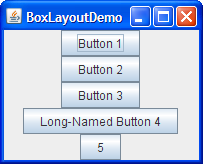如何使JLabel从下一行开始
JPanel pMeasure = new JPanel();
....
JLabel economy = new JLabel("Economy");
JLabel regularity = new JLabel("Regularity");
pMeasure.add(economy);
pMeasure.add(regularity);
...
当我运行上面的代码时,我得到了这个输出:
Economy Regularity
如何获得此输出,每个JLabel在新行上启动?谢谢
Economy
Regularity
5 个答案:
答案 0 :(得分:19)
您需要使用layout managers来控制JPanel中控件的位置和大小。布局管理器负责放置控件,确定它们的位置,它们的大小,它们之间的空间大小,调整窗口大小时会发生什么等等。
有大量不同的布局管理器,每个布局管理器都允许您以不同的方式布局控件。默认布局管理器是FlowLayout,正如您所见,它只是将组件从左到右放置在彼此旁边。那是最简单的。其他一些常见的布局管理器是:
-
GridLayout- 在具有相等大小的行和列的矩形网格中排列组件 -
BorderLayout- 中间有一个主要组件,上方,下方,左侧和右侧最多有四个周围组件。 -
GridBagLayout- 所有内置布局管理器的Big Bertha,它是最灵活但也最复杂的使用。
例如,您可以使用BoxLayout来布置标签。
BoxLayout要么将其组件堆叠在一起,要么将它们放在一行 - 您的选择。您可能会将其视为FlowLayout的版本,但具有更强大的功能。下面是一个应用程序的图片,演示了使用BoxLayout显示组件的居中列:

使用BoxLayout的代码示例如下:
JPanel pMeasure = new JPanel();
....
JLabel economy = new JLabel("Economy");
JLabel regularity = new JLabel("Regularity");
pMeasure.setLayout(new BoxLayout(pMeasure, BoxLayout.Y_AXIS));
pMeasure.add(economy);
pMeasure.add(regularity);
...
答案 1 :(得分:5)
我读了这段代码:
pMeasure.setLayout(new BoxLayout(pMeasure, BoxLayout.VERTICAL));
似乎BoxLayout没有VERTICAL。在搜索时,这将使用以下代码:
pMeasure.setLayout(new BoxLayout(pMeasure, BoxLayout.Y_AXIS));
答案 2 :(得分:2)
以下是您需要使用的内容:
JLabel economy = new JLabel("<html>Economy<br>Regularity</html>");
答案 3 :(得分:0)
快速的方法是在JLabel中使用html。
例如,包含<br/>标记。
否则,实施BoxLayout。
答案 4 :(得分:0)
为每一行创建一个单独的JPanel,并设置尺寸以适合每个单词:
JLabel wordlabel = new JLabel("Word");
JPanel word1 = new JPanel();
word1.setPreferredSize(new Dimension(#,#);
这适用于每个单词。然后,您可以将每个JPanel添加到主JPanel。这也允许您在每个单词旁边添加其他组件。
相关问题
最新问题
- 我写了这段代码,但我无法理解我的错误
- 我无法从一个代码实例的列表中删除 None 值,但我可以在另一个实例中。为什么它适用于一个细分市场而不适用于另一个细分市场?
- 是否有可能使 loadstring 不可能等于打印?卢阿
- java中的random.expovariate()
- Appscript 通过会议在 Google 日历中发送电子邮件和创建活动
- 为什么我的 Onclick 箭头功能在 React 中不起作用?
- 在此代码中是否有使用“this”的替代方法?
- 在 SQL Server 和 PostgreSQL 上查询,我如何从第一个表获得第二个表的可视化
- 每千个数字得到
- 更新了城市边界 KML 文件的来源?